Summary, abstract and full texts n° 104
Philippe Mesnard and Yannis Thanassekos: Editorial: Vingt ans après : À l'Est, du nouveau(pdf in French)(pdf in Dutch)
Dossier: L'Antifascisme revisité. Histoire – Idéologie – Mémoire
Coordinated by Carola Hähnel-Mesnard
Carola Hähnel-Mesnard: L'antifascisme - Quelle actualité ? (pdf)
I. Historical Prospects
Frediano Sessi: L’antifascisme et la résistance en Italie, 1922-1945 (pdf)
-
In its initial stages Italian antifascism was solely a movement of parliamentary protest which did not ask itself what means would really enable it to fight the new regime. The assassination of Matteotti and the definitive suppression of political parties and press and trade union freedom, together with the installation of "ultra-fascist" laws in 1926 and the establishment of the special tribunal for the defense of the State, made it clear that in future it would only be possible to oppose the fascist State through secret struggle. This led many Italians to emigrate secretly, mainly for political reasons (and not for intellectual reasons as was the case in the Third Reich). Those who secretly went abroad were socialists, communists and radical democrats, whose most noteworthy expression could be found in the "Justice and Freedom movement". These movements, together with a Catholic opposition, also existed inside Italy. Clandestine antifascism was maintained by a small minority who formed a circle of political personalities and subsequently joined the resistance. Resistance in the form of armed struggle really began on 8 September 1943, with the announcement of the armistice between Italy and the Allies, and continued until the end of the war as a struggle against both fascism and nazism.
Andreas Agocs: Restrained Revolution: Antifascist Committees in Occupied Germany, 1945-1946 (pdf)
-
This paper analyzes the role of the numerous antifascist « action groups » and committees (Antifas) that emerged in Germany during the breakdown of the NS regime and the early months of Allied occupation. The essay argues that these groups contained both elements of the mass politics of the prewar period and aspects of the more atomized politics of postwar societies. The Antifas movement was part of the larger revolutionary upheaval that transformed the social, political, and ideological structures in Europe between 1930 and 1950 and fundamentally transformed the public sphere of the interwar and war eras.Although the Antifas have been described as « initiatives with revolutionary potential », their activities, usually in cooperation with the Allies in both the east and the west, were comparatively restrained. Their establishment of workers councils made a lasting contribution to the postwar order but their attempts to become mass movements failed, not only because of Allied restrictions and prohibitions, but also owing to a lack of interest among the German population. The Antifas’ rhetoric and self-understanding evoked the paramilitary politics of the interwar period, while the experiences and social disruptions of the NS-period and the war meant that many Germans were content to leave politics and retribution to the new broad-based parties (Volksparteien) and the courts, rather than to grassroots mass movements. The idea of antifascism therefore ceased to be a revolutionary concept in the West. At the same time, the prohibition of the Antifas in the Soviet Occupation Zone paved the way for the SED’s centralized control over the GDR’s « antifascist mass organizations », which had little in common with the so-called « activists of the first hour » in the Antifas. Ultimately, therefore, the immediate postwar period can be characterized as an irrevocable process of « de-revolutionizing » the potential of antifascist activism.This paper analyzes the role of the numerous antifascist "action groups" and committees (Antifas) that emerged in Germany during the breakdown of the NS regime and the early months of Allied occupation. The essay argues that these groups contained both elements of the mass politics of the prewar period and aspects of the more atomized politics of postwar societies. The Antifas movement was part of the larger revolutionary upheaval that transformed the social, political, and ideological structures in Europe between 1930 and 1950 and fundamentally transformed the public sphere of the interwar and war eras.
Although the Antifas have been described as "initiatives with revolutionary potential", their activities, usually in cooperation with the Allies in both the East and the West, were comparatively restrained. Their establishment of Workers' Councils made a lasting contribution to the postwar order but their attempts to become mass movements failed, not only because of Allied restrictions and prohibitions, but also owing to a lack of interest among the German population. The Antifas’ rhetoric and self-understanding evoked the paramilitary politics of the interwar period, while the experiences and social disruptions of the NS-period and the war meant that many Germans were content to leave politics and retribution to the new broad-based parties (Volksparteien) and the courts, rather than to grassroots mass movements. The idea of antifascism therefore ceased to be a revolutionary concept in the West. At the same time, the prohibition of the Antifas in the Soviet Occupation Zone paved the way for the SED’s centralized control over the GDR’s "antifascist mass organizations", which had little in common with the so-called "activists of the first hour" in the Antifas. Ultimately, therefore, the immediate postwar period can be characterized as an irrevocable process of "de-revolutionizing" the potential of antifascist activism.
André Koulberg: L’antifascisme en France hier et aujourd’hui. Questions d’interprétation (pdf)
- For the last twenty years, few books dealing with antifascism have been available in France. This lack of interest is in fact a disavowal. A number of French historians specializing in the far right have questioned the relevance of the term "fascism" brandished by antifascists. Was this simply a mistake on their part? A close examination of their positions tends to show that their way of thinking and conceptualization were more coherent than first thought. In turn, these analyses enable us to question the methodology used by the historians.
- The armed resistance to Hitler by the Slovenes of Carinthia, the first such resistance inside Greater Germany and the only resistance in Austria which troubled the Nazi war machine, is distinguished by its "extra-territorial" (Yugoslav communist) military organization and its ethnic dimension. Recalling the history of the structural repression of Austria’s Slovene minority from the nineteenth century until the Nazis’ brutal policy of Germanization makes it easier to define the motives behind this movement, supported by a section of the population which was not a priori naturally inclined towards resistance. While there were only isolated acts of active resistance during the period from the Anschluss in March 1938 to the attack on Yugoslavia in April 1941, passive resistance by the Slovene minority in the form of disobedience increased. Openly persecuted with a view to ethnic homogenization, and subject to mass deportation in April 1942, many Carinthian Slovenes joined the Slovene Liberation Front and Tito’s partisans as resistance fighters. In 1945 the south of Carinthia was liberated by Tito’s Yugoslav army, which demanded the annexation of the southern part of the province, thus triggering old and new fears ("slavization" and communism). Inside Austria, whose patchy cultural memory is notorious, Carinthia’s border status and double culture make it a special case, as the antifascist remembrance of the Slovene partisans not only remains controversial for political reasons, but also seems to be permanently marked by its ethnic dimension.
II. Antifascism and the Cold War: ideology and discourses
- The history of the Association of Those Persecuted by National Socialism (Vereinigung der Verfolgten des Naziregimes) shows that all-German antifascist activities after 1945 were dependent on the context of the Cold War. While the organization was stigmatized as communist in the West, it was dissolved as unnecessary in the East. The confrontation of the two political systems overrode antifascist positions.
- In 1945, as soon as the war was over, antifascist women from 37 countries met in Paris to create the Women’s International Democratic Federation (Fédération Démocratique Internationale des Femmes), a transnational women’s organization whose stated goal was to ensure that fascism was completely crushed and the gains of the antifascist victory preserved. These women, most of whom had ties to national communist parties, were also to carry out major propaganda and defense work on behalf of the Soviet Union, in an international context marked by the coming of the Cold War. To achieve these goals, they reactivated militant practices and declarations which had already been employed in 1930’s antifascism. But they also built up a policy relating to maternity which justified their action in the public arena and led to a pacifist policy taken over by the Soviet Union in its propaganda war against the West.
III. Plurality versus uniformity: antifascist discourses in GDR
Anne Kwaschik: L’antifascisme au féminin : La RDA et Ravensbrück (pdf)
- The article aims to describe the characteristics of the "commemorative situation" of Ravensbrück at the end of the 1950’s. The only concentration camp for women, which was located in the GDR, found itself obliged to picture itself and develop on the basis of the categories used for Buchenwald, without losing its own specificities but, on the contrary, by stressing its difference. The article follows the process of negotiation over the historic elements to be retained, on the basis of two specific moments which crystallize the work of remembering: the discussions concerning the monuments which should be built inside the camp; and the literary narrative which would be acceptable as the "correct presentation" of life in the concentration camps. Thus the article examines the difficulties of the women’s camp in finding its place beside Buchenwald, stressing the ambiguous nature of this remembrance modeled on another commemoration.
- The following is a case study of an exhibition about members of the "Rote Kapelle" resistance group. Focusing on competing understandings of antifascism in the exhibition, I argue that Greta Kuckhoff was instrumental in challenging memories in both the GDR and FRG. Using concepts of the "residual" and "conjuncture", I show how the cultural turn in contemporary discussions of antifascism problematises dominant, monolithic ways of remembering.
- Discussion of the remembrance of antifascist resistance in the GDR focuses on the way in which the SED exploited it in order to stabilize its rule. The culture of the former resistance fighters who did the reminding in the so-called "Committees of antifascist resistance fighters" has hardly been noticed. The author had the opportunity to examine the autobiographical records of one of their members, Herbert Ansbach.
- When the Spanish Communist Party (PCE) was banned by the French Government in 1950, approximately 90 members went into exile in the GDR. By order of the Socialist Unity Party of Germany (SED), they were provided with all the financial and material means they needed, giving them a way of life well up to average German standards in those times. The much disputed "antifascist myth" seems to have become a reality in this case.
IV. Glorification and ideological recovery
- Youth education and children’s literature in communist East Germany promoted gendered images of communist antifascist resistance fighters, privileging masculine heroes engaged in high political and military action and marginalizing the contributions of women in supportive roles. Veteran antifascists and minority storytellers have questioned this hierarchy and complicated the antifascist master narrative.
Bill Niven: The GDR, Weimar Classicism and Resistance at Buchenwald (pdf)
- This article examines the relationship in East Germany between Buchenwald’s National Site of Warning and Commemoration and the National Research and Memorial Centre for Classical German Literature in Weimar. It argues that although they were separate organizations, they were linked by the GDR’s political and cultural authorities in an effort to prove that antifascist resistance at Buchenwald represented an expression of the same humanism as that enshrined in Germany’s classical legacy.
V. The legacy of antifascism
- Antifascism served as the backbone for the GDR’s political and ideological self-perception. Historians in the GDR defended a particular model of interpretation of fascism, Hitler and the Third Reich. The GDR proudly presented itself as the "other" and "better Germany" which had succeeded in freeing itself from the burdens of the Nazi past. After Germany’s reunification a process of political and ideological reorientation started, and the writing of history in the former East Germany underwent a drastic reconstruction. How then, and to which extent could the old idea of antifascism survive, both as a moral conviction and a historical conception? Are former GDR historians still attached to the old notions and theory of antifascism? Two trends can be distinguished. Former GDR historians generally tend to criticize the old dogmatism and political instrumentalizing which characterized the historical profession in the GDR. Most of them, however, have remained attached to a minimal consensus of antifascism as a moral conviction. Antifascism serves as the source of a moral engagement, enabling former GDR historians to defend both the historic reason for the GDR’s existence as a separate state and their personal role in it.
Other subjects
- Is it really a film which commemorates Auschwitz? Announced as "the film that commemorates Auschwitz" when it was released in 1998, La Vita è bella [Life is Beautiful] gave rise to various disputes among those involved in studying the Shoah. Among the film’s various eventual qualities and flaws, the author’s comments are based on her conviction that it is mainly about the "new fathers". Not only is it about the father-child relationship, but it also denounces fascist and racist stereotyped fantasies of virility and patriarchy. In this context, Auschwitz served only to give a dramatic motivation to the story told in the film.
Frediano Sessi: Auschwitz, Bloc 21 : Une question ouverte (pdf)
- The debate which arose in Italy over the pavilion dedicated to the Italian deportation, installed in Block 21 at Auschwitz and inaugurated in April 1980, at once took a disquieting turn. Both the National Association of Former Deportees (ANED, the legal owner of the memorial) and the Institute for the History of the Resistance and the Contemporary Era (ISREC) refused to touch the memorial. Furthermore, the memorial is a tormented work of art which reflects the wishes of those who personally lived through the drama of the deportation. But on the other hand, why not think of moving it, as it is, and exhibiting it as a work of art and remembrance in a museum in Italy, where it would be able to reach out to many young people and thus fulfill a didactic function?
- My article deals with the aesthetic and philosophical choices I made in the creation of Holocaust Portraits, Victims Perpetrators Witnesses.
The key points I make are:
1. All people were victimized by their experiences during the Holocaust. Understanding the root causes of the Holocaust requires an understanding that ordinary people were the victims of the perpetrators and the executioners of this tragedy.
2. Visual reality is fundamentally different from a literary description of reality. In my artwork I seek to enhance a contemporary viewer’s understanding of and emotional reaction to Holocaust experiences through a visual portrayal of the people who were its perpetrators' victims and witnesses.
3. Understanding why, by whom and how the Holocaust occurred is an essential part of understanding past political and moral misjudgments as we today seek to strengthen democracy, fight racism, and secure human rights for all the world’s people.
The journal is available on line at
openedition.org
All issues
-
No. 138 (04/2024) Trials
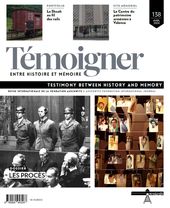
This dossier will deal with trials that have provided a legal answer to a demand for justice. Several cases will be addressed ranging from Istanbul and the Nuremberg Doctors' trial to the German policemen of the Brussels Jewish section and the gacaca trials in Rwanda.
Table of contents (Dutch version)
Table of contents (French version)No. 137 (10/2023) Children's Literature in Light of the Holocaust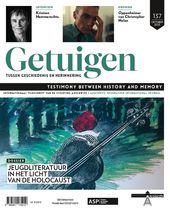
In France and Belgium, research into the relationship between children's literature and the Holocaust is rare, in contrast to the phenomenal attention in America (everyone knows Art Spiegelman's Maus) and in other English-speaking countries. Yet children's books depicting the Holocaust in words and pictures have been steadily gaining ground in post-war France and Belgium. While literary criticism and research still seem to be in their infancy, this dossier will show that critical analysis of this corpus is highly relevant for the future.
Table of contents (Dutch version)
Table of contents (French version)No. 136 (04/2023) The Executioners
The executioner has always fascinated and frightened. The perpetrators of mass crimes are those who carry out, facilitate or order the annihilation of a specific group. Issue 100 of Testimony: Between History and Memory, published in September 2008, examined the Nazi executioners. This dossier offers readers a historical and criminological approach to other genocides of the 20th century.
Table of contents (Dutch version)
Table of contents (French version)No. 135 (10/2022) Disobedience
This issue looks at the concept of disobedience in wartime. While the concept of civil disobedience may seem familiar in these times of endemic protest, there was a time when obedience was the rule. In a military context, disobedience was frequently followed by deadly consequences. This dossier focuses on three cases from the First World War and one from the Algerian War (1954-1962).
Table of contents (Dutch version)
Table of contents (French version)No. 134 (04/2022) The Killing of the ‘Useless’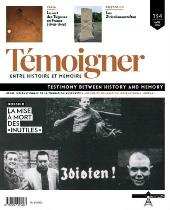
During the Second World War, the Nazi regime didn't just try to destroy the Jewish "race", which it considered dangerous. Before implementing the Final Solution, the Nazis massacred those who didn't fit in with their eugenic racial ideology and whom they considered inferior. In this dossier, we focus on the mentally and physically handicapped, systematic victims of Nazi pseudo-medical madness throughout the world conflict.
Table of contents (Dutch version)
Table of contents (French version)No. 133 (10/2021) 1918-1938: The politicisation of music in Europe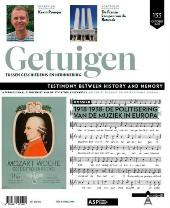
1918-1938: The politicisation of music in Europe
This dossier looks at the instrumentalisation of music by the political world between the wars. The cases are numerous and shed light on the way in which political propaganda was propagated in European musical culture.
Table of contents (Dutch version)
Table of contents (French version)No. 132 (04/2021) AKTION REINHARDT and AKTION ERNTEFEST
AKTION REINHARDT and AKTION ERNTEFEST
The Aktion Reinhardt saw approximately 1.8 million Polish Jews perish in the gas chambers of Bełżec, Sobibór, Treblinka and Majdanek between March 1942 and November 1943. The Jews who ‘escaped’ the gas chambers were shot in Majdanek, Trawniki and Poniatowa on 3 and 4 November 1943 during Aktion Erntefest. The dossier we are proposing takes stock of current research on the Aktion Reinhardt. This historical event has experienced a resurgence of interest among historians of the Shoah over the last fifteen years, thanks, among other things, to archaeological advances at the various sites concerned. We have come a long way since Yithzak Arad's pioneering work in 1987: Belzec, Sobibor, Treblinka: the Operation Reinhard Death Camps. The dossier highlights different perspectives to discuss current research related to the issue. It addresses the erasure of traces, the sociological perspectives of the executioners, the excavation of extermination sites and the most recent historiography.
Table of contents and abstracts (Dutch version)
Table of contents and abstracts (French version)No. 131 (10/2020) Historiography of the Second World War in the Far East
Historiography of the Second World War in the Far East
For many people, 8 May 1945 and the surrender of Nazi Germany is the final chapter of the Second World War. However, it is often forgotten that the months between May and September 1945 were decisive for the future of the world, as fierce fighting continued in the Pacific between the United States and the Japanese Empire until the latter’s unconditional surrender on 2 September 1945, the actual date of the end of the Second World War.Table of contents and abstracts (Dutch version)
Table of contents and abstracts (French version)No. 130 (04/2020) Reception of the Shoah and mentalities in Jewish and Christian circles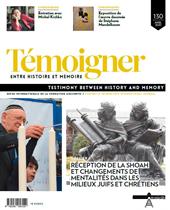
Reception of the Shoah and mentalities in Jewish and Christian circles
The reception of the Shoah has become, for all of humanity, a place of questioning and awareness. This dossier will aim to establish and evaluate the modalities and challenges of the transmission of the Shoah and to measure the resulting changes in identities and mentalities. What were the Catholic views on Judaism before and during the Shoah? What Jewish liturgies and interreligious rites exist for the commemoration of the Shoah in Israel and the United States? The evolution of mentalities in the Jewish world in relation to the Shoah will also be exposed through the analysis of the so-called Bitburg controversy, triggered by the visit of the American President, Ronald Reagan, to the German military cemetery of Bitburg (FRG) in May 1985. The Auschwitz Carmel affair (1985-1993) finally reveals the involvement of the Belgian and French Churches in the resolution of the conflict and is undoubtedly a key stage in the Church's 'teaching of esteem' with regard to the Jews. The historical answers provided in this dossier to the question of the Shoah may be decisive for the survival of Judaism and the relationship between Judaism and Christianity.
Table of contents and abstracts (Dutch version)
Table of contents and abstracts (French version)No. 129 (10/2019) Recognition of victims
Recognition of victims
In recent decades, the idea has gained ground that victims of mass crimes deserve recognition. This has become an essential category of our memorial culture. This dossier aims to take stock of this issue by looking at the broad spectrum of measures to ensure recognition, from simple remembrance to targeted judicial interventions, and by recalling the growing importance of the victim in international criminal justice. It returns to the problematic aspects of recognition when it leads to competition among victims.
Table of contents and abstracts (Dutch version)
Table of contents and abstracts (French version)No. 128 (04/2019) 25 years on, how to remember the Tutsi genocide
Kwibuka [Remember]. 25 years on, how to remember the Tutsi genocide
April 1994. Images of mutilated bodies are projected on European screens, originating from Rwanda. 25 years later, we remember.Table of contents and abstracts (Dutch version)
Table of contents and abstracts (French version)No. 127 (10/2018) Perpetuation of violence after 1918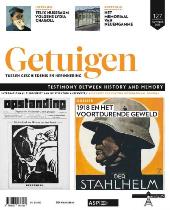
Perpetuation of violence after 1918
One hundred years ago, the First World War ended in November 1918. After four years of bloodshed, peace returns to Europe. At least, that was the impression of the victors at the time, and today it is also the impression of the commemorators who celebrate its centenary. The historical reality is more complex. At least until 1923, violence continued in the form of revolutions and counter-revolutions, wars and civil wars. The spirits also remain in the grip of violence on both the left and the right. The dossier proposes to define the contours of this Europe so strongly marked by the Great War, by evoking the culture of violence established by it and which, finally, degenerated into the total explosion of the Second World War.
No. 126 (04/2018) Questions about the future of remembrance work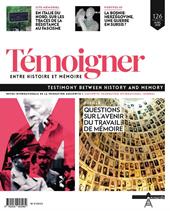
Questions about the future of remembrance work
On 20 and 21 January 2017, the seminar ‘Questions on the future of remembrance work’ was held in Esch-sur-Alzette, Grand Duchy of Luxembourg. The five articles in this dossier taken from the conference proceedings attempt to answer the following questions: How can we build a critical memory of the Shoah, free of myths and national fragmentation? How do we anticipate the absence of direct witnesses? In the future, who transmits what, and how?
No. 125 (10/2017) Persecution of homosexuals by the Nazis
Persecution of homosexuals by the Nazis
Historical knowledge of the Nazi persecution of homosexuals and their deportation has made significant progress in recent years due to the increase in research on the subject. In this dossier, recognised researchers as well as young doctoral and PhD students take the floor. The insights they provide concern both the question of the singular destiny of homosexual men and women during the Second World War and the way in which the memory of the homosexual victims of Nazism has evolved since the end of that war.
No. 124 (04/2017) Music in the camps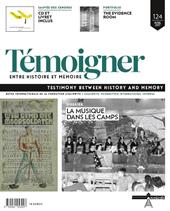
Music in the camps
Music was an integral part of the concentration camp world, Nazi and otherwise. What kind of music was composed and performed, and what exactly was its role in the camps? A factor of survival and resistance for the prisoners, a way for them to express their hope and their humanity - or, on the contrary, an instrument of oppression exploited by the executioners? What is the function of music in the work of memory following the experience of extreme violence and suffering? This dossier proposes to explore these issues.
No. 123 (10/2016) Translating Memory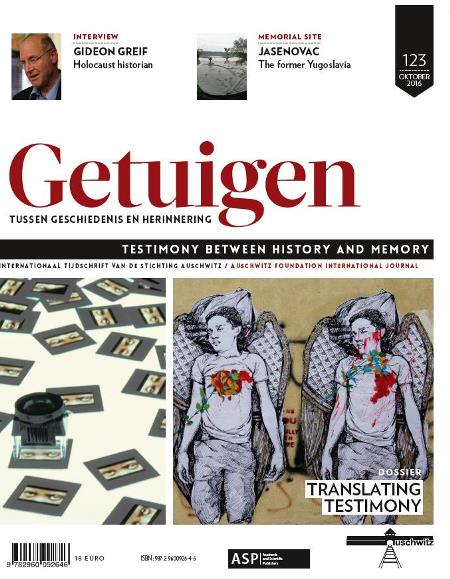
Translating Memory
Presentation of the dossier: What is the relationship between testimony, defined as a more or less ritualized firstperson account of political violence, and translation? Correspondingly, how does the translator position herself towards the witness? Can the translator be, or become, a witness? How, when and why are testimonies translated? Which linguistic and discursive strategies do translators resort to when faced with ethically challenging texts? Which role do they play exactly in the transmission of the historical knowledge, cultural values or social critique conveyed by the testimony? Does translation weaken or rather reinforce the relevance and impact of the original statement? How important is translation in literary, political and institutional settings? Do these specific settings determine translation practice in significant ways? To which extent can subsequent processes of transcription, editing, translation and archiving affect the source text? And how accurate are the boundaries we draw to distinguish witnessing from translating, documentary from literary testimony, the original from its translation? These are the main questions we intend to explore in our dossier.
No. 122 (04/2016) Revisionism and negationism
Revisionism and negationism
Strictly speaking, Holocaust denial is the ‘doctrine denying the reality of the Nazi genocide of the Jews, including the existence of the gas chambers’; by extension, the term refers to the denial of other genocides and crimes against humanity. The literature on Holocaust denial is extensive. There are studies on the subject in many countries as well as biographies of deniers. The argumentative and rhetorical strategies of the deniers have been widely deciphered. Websites systematically dismantle their fallacies. While there is no shortage of reliable information on the phenomenon, it is essential to return to it again and again, for several reasons.
No. 121 (10/2015) Extreme violence on stage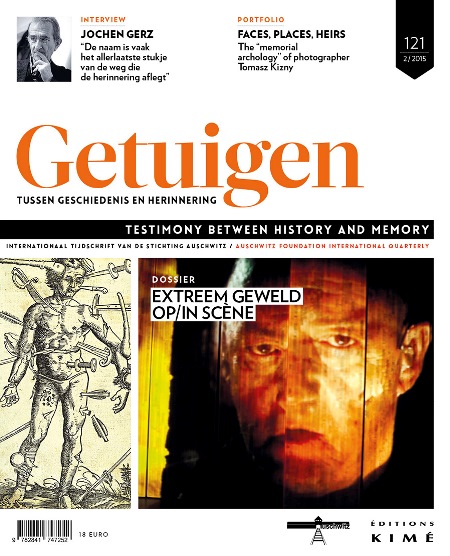
Extreme violence on stage
Extreme violence shows itself. It bursts through the screens. It surfs from one style and medium to another: news reports, documentaries, fiction, arts of all kinds. Yet theatre distinguishes itself from this mêlée all while constantly returning to the subject. Differently. Linked from its origins to the representation of cruelty and having “miraculously” escaped the often sterile polemics on the interdiction (or not)... of representing the Holocaust, it is still with the same youthfulness that theatre deals with extreme violence today, relentlessly pursuing the articulation of ethics and aesthetics.
No. 120 (04/2015) What future is there for the memory of the Armenian genocide?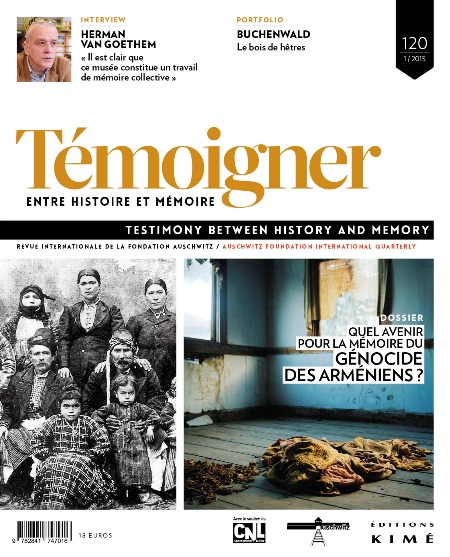
What future is there for the memory of the Armenian genocide?
The 1915 genocide of Turkish Armenians still stirs up numerous debates, controversies, declarations of principle, statements and counter-statements, and even negation. However, as we speak, ties are being established more and more openly, bridges are built and bonds strengthened between the Armenian and Turkish communities. Is reconciliation possible?
No. 119 (12/2014) 70 years ago, Auschwitz. Looking back on Primo Levi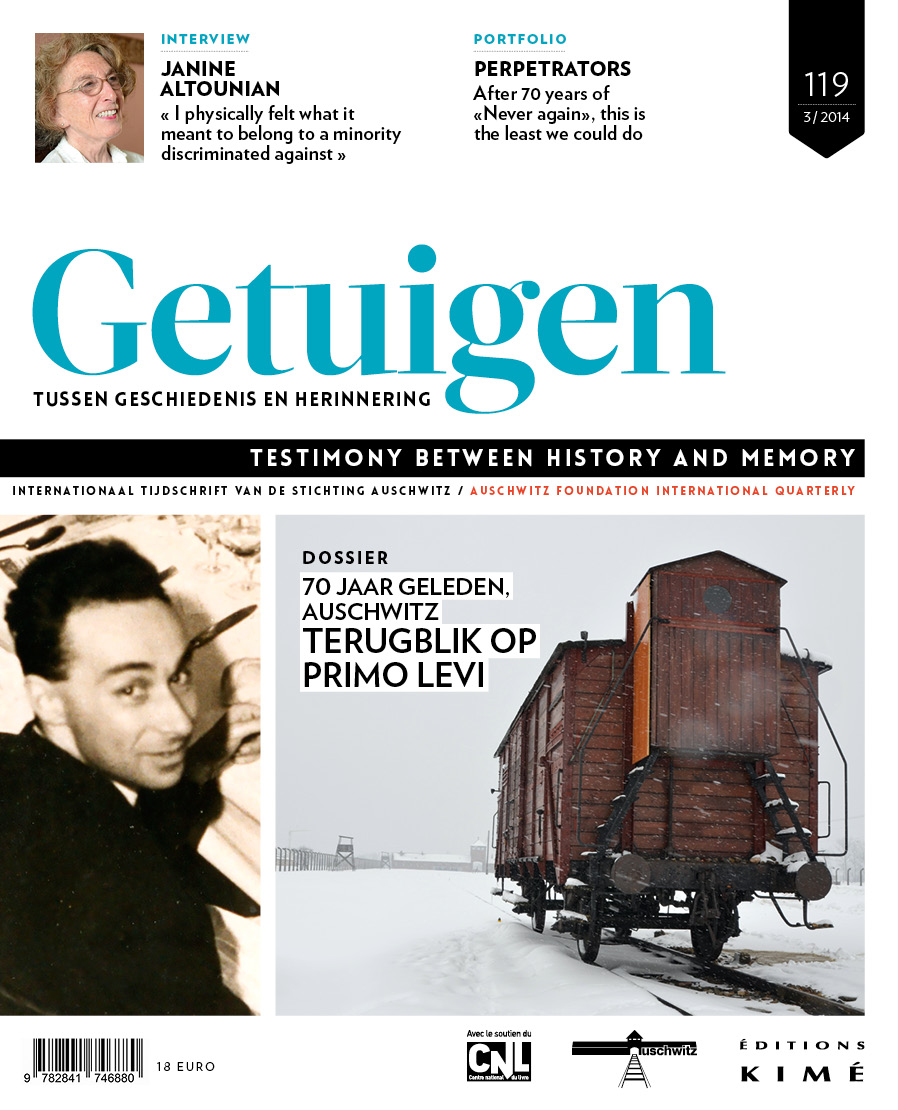
70 years ago, Auschwitz. Looking back on Primo Levi
27 January 1945. Seventy years ago the first soldiers of the Red Army marched into Auschwitz. One might argue that the camp was “liberated” then, but the truth is that neither Auschwitz, nor any of the other Nazi camps, was ever a priority to the Allied Powers. Primo Levi was one of the few survivors who knew how to hide and escape the enforced evacuation of the camps. With this dossier, we want to cast light on the complex figure that Levi was: a Jew, a deportee, a chemists, a witness, and a writer. It sets out to study his oeuvre and his interpretation of the notions of “resistance” and “engagement”, in order to understand how he eventually became a “professional survivor”, as he once described himself.
No. 118 (09/2014) Dictatorship and terror in Argentina, Chile and Uruguay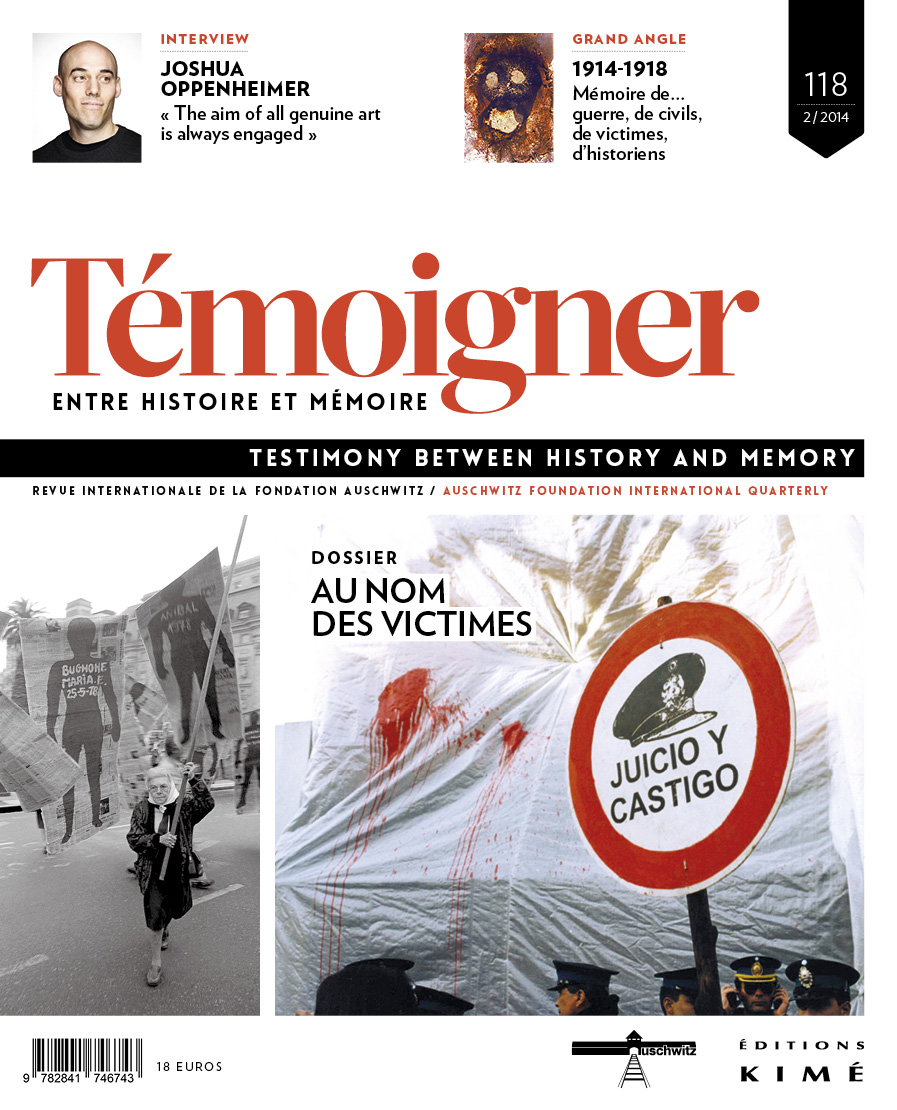
In the name of the victims. Dictatorship and State terror in Argentina, Chile and Uruguay
During the 1970s and 1980s, Argentina, Chile and Uruguay were in the grip of military dictatorships. The process of democratic transition that followed the long period of state terror involved the construction of particular narratives and memories, leading to a reconfiguration of the past. Despite local differences, this process is very much centered at the figure of the victim – a figure the articles in this dossier, collected by Claudia Feld, Luciana Messina and Nadia Tahir, set out to explore.
No. 117 (03/2014) Friends? Enemies? Relationships between memoriesAmis ? Ennemis ? Relations entre mémoires / Vriend of vijand? Hoe herinneringen zich tot elkaar verhouden [Friends? Enemies? Relationships between memories]
Much has been said and written about group memories, limiting their mutual relationships and history to conflicts, “wars”, competitions, or strategies for eclipsing or silencing. These terms have now become the platitudes of a kind of more general doxa about collective and cultural remembrance. This dossier proposes a critical reading of those terms and of that doxa by questioning the emergence, constitution, and inter-relating of different exemplary memories of the major violent episodes of the 20th century. It will address the relationships that those memories can maintain with other memories with which they share, if not the same event, at least similar characteristics and concerns.
No. 116 (09/2013) Memory tripsVoyages mémoriels / Herdenkingsreizen [Memory trips]
Should we fear what has been grouped under the term “memorial tourism”? Or should we take this as a reality of our time? Can any visitor, group or individual, nowadays be absorbed in the category of “tourist”? Or is this category a remote intellectual reduction of a personal experience that everyone is aiming during his visit? The problem appears in a somewhat different light when we think of tours for young people supervised by adults, usually teachers. This dossier gives the floor to historians and teachers with experience in the field.
No. 115 (03/2013) Memory construction in SpainL’Espagne en construction mémorielle / Spanje en de opbouw van de gedachtenis [Memory construction in Spain]
This dossier’s objective is to provide a benchmark for understanding the plural identities and relationships between memories and representation forms in contemporary Spain. Indeed, it is necessary today to take a fresh look not only on the stratified memories of the civil war, exile and the Franco repression, but also on the reception of other memories such as that of the Holocaust, and to propose new readings. We propose to highlight the conflicting or fruitful tensions between official actions, initiatives of associations and of artistic events.
No. 114 (12/2012) Memorial SitesSites mémoriels / Gedenkplaatsen [Memorial Sites]
Memorial sites constitute the concrete trace of European remembrance and history of the twentieth century. But what do they look like today? Exhibition and conservation criteria have changed during the last ten to fifteen years, like advances in historical research have changed the way we read and reconstruct past events. This is not only due to the fact that we have moved from a past history written by witnesses to a history written by professional historians. A new consciousness has emerged concerning transmission methods (memory education), and archeology has strengthened historical research. We tore off the veil of ideology that often influenced and prescribed the way we imagined permanent exhibitions, conservation and visits. Can we say we have entered a new era in memory transmission? It remains, in many ways, an open bet on the present and the future.
No. 113 (09/2012) The Taboos of German HistoryLes tabous de l'histoire allemande / De taboes van de Duitse geschiedenis The Taboos of German History]
The most painful or ambiguous periods in twentieth-century German history are characterized by numerous taboos, expressed in literature, photography and film as so many “returns of the repressed”. These studies focus in part on problems of antisemitism, and thus on the relationship of German-speaking societies to the Shoah. They also examine the way in which those societies confronted the violence they suffered, such as bombing, fleeing from the Red Army and the expulsions, and mass rapes.
No. 112 (06/2012) Children of the Spanish Civil WarLes enfants de la Guerre d'Espagne. Expériences et représentations culturelles / De kinderen van de Spaanse Burgeroorlog. Ervaringen en culturele voorstellingen [Children of the Spanish Civil War: Experiences and Cultural Representations]
The dossier in this issue deals with the experiences and cultural representations of childhood during the Spanish Civil War. It aims to help towards a better understanding of that conflict, which tore apart a population living on the same territory, by confronting the experiences of Spanish children who lived through it – as expressed in various forms during or after the war – with representations of those same children, particularly those coming from adults.
No. 111 (12/ 2011) Dangerous Game between Art and PropagandaArt & propagande : jeux inter-dits / Gevaarlijk spel tussen kunst en propaganda [Dangerous Game between Art and Propaganda]
Since the media came into existence, political institutions from political parties to governments have used them to promote their image, in order to win the support of the public they addressed. Authoritarian powers use the media as a means of consolidating their domination. But how can artists take part in propaganda, whose purposes are the opposite of those generally attributed to art? Does that mean setting aside their vocation, or do they themselves distort that vocation?
No. 110 (10/2011) Displacements, Deportations, ExileDéplacements, déportations, exils / Volksverhuizingen, deportaties, verbanningen [Displacements, Deportations, Exile]
States and criminal groups exploit population displacements to isolate or get rid of certain populations. In addition to being denied their normal rights, these populations lose visibility and are deprived of their reference points and social frameworks. In this way it is possible to make them the victims of constraints (deterritorialization, forced labor…) or violence (famine, massacres genocide…). These developments have spread on an unprecedented scale since the First World War and continue to grow worldwide. But there is also a dimension of remembrance to this reality: memories of these displacements are now being expressed in literature, and in exhibitions and museums. This dossier examines the contemporary double aspect of history and memory.
No. 109 (03/ 2011) 20th Century Wars and Genocides in Graphic Novels and Comic StripsLa bande dessinée dans l'orbe des guerres et des génocides du XXe siècle / Twintigste-eeuwse oorlogen en genociden in het stripverhaal [Twentieth Century Wars and Genocides as Portrayed in Graphic Novels and Comic Strips]
No. 108 (09/2010) How Documentaries Handle HistoryLe traitement de l'histoire dans les documentaires filmiques / De behandeling van de geschiedenis in de documentaire film [How Documentaries Handle History]
No. 104 (09/2009) Anti-fascism Revisited: History, Ideology, RemembranceL'Antifascisme revisité. Histoire – Idéologie – Mémoire / Nogmaals antifascisme. Geschiedenis, ideologie, gedachtenis [Anti-fascism Revisited: History, Ideology, Remembrance]
No. 103 (06/ 2009) Nazi Crimes and Genocides on the ScreenCrimes et génocides nazis à l'écran / Nazimisdaden en genociden op het scherm [Nazi Crimes and Genocides on the Screen]
No. 102 (03/ 2009) The Portrayal of Political Criminals in Films, Plays, Literature...Criminels politiques en représentation. Arts, cinéma, théâtre, littérature, médias / De representatie van politieke misdadigers. Kunst, film, theater, literatuur, media [The Portrayal of Political Criminals in Films and Plays, in Literature and in the Media]
No. 101 (12/2008) How to Educate, How to Remember?Quelle pédagogie, pour quelle(s) mémoire(s) ? / Welke pedagogie, voor welke herinnering(en)? [How to Educate, How to Remember?]
No. 100 (09/2008) Questions about the “Executioners”Questions de « bourreaux » / De kwestie van de “beul” [Questions about the “Executioners”]
Contact
Auschwitz Foundation – Remembrance of Auschwitz
Rue aux Laines 17 box 50 – B-1000 Brussels +32 (0)2 512 79 98
+32 (0)2 512 79 98 info@auschwitz.be
info@auschwitz.be
BCE/KBO Auschwitz Foundation: 0876787354
BCE/KBO Remembrance of Auschwitz: 0420667323
Office open from Monday to Friday 9:30am to 4:30pm.
Visit only by appointment.![]()
![]()
![]()
![]()
Become a member
To become a member of Remembrance of Auschwitz ASBL, take part in its activities and support its actions, please contact us.
Membership costs €40.00, payable to account n° 310-0780517-44 (IBAN : BE55 3100 7805 1744 – BIC : BBRUBEBB)
Donations of more than €40.00 qualify for a tax exemption for Belgian tax-payers.








































